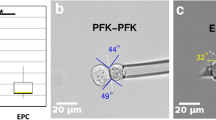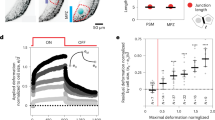Abstract
Contact guidance1,2 has been implied in various morphogenetic movements including neural crest cell migration3, primordial germ cell migration4 and guidance of axonal growth cone5. In urodele gastrulae, we reported6 the presence of an aligned network of extracellular fibrils on the inside of the ectodermal layer and suggested that it guides the migration of the presumptive mesodermal cells from the blastopore towards the animal pole. We also reported7 in vitro experiments in which the fibril network of the ectodermal layer was transferred onto the surface of a coverslip. Dissociated mesodermal cells attach to and locomote actively on such conditioned surfaces in an oriented fashion along the blastopore–animal pole axis (bp–ap axis) of the ectodermal layer that conditioned the surface. Recent reports8,18 suggest that these fibrils contain fibronectin. We now report that the fibril network on the conditioned surface can be artificially aligned in any orientation by exerting mechanical tension on the ectodermal layer during the conditioning. Such prepared surfaces cause cell movements aligned along the tension axis, even when the tension axis is perpendicular to the natural axis of alignment along the bp–ap axis. These results suggest that the extracellular matrix fibrils aligned by the mechanical stress that arises in embryos during development can orient cell migration by the contact guidance, in a similar manner to that reported in the collagen gel and fibroblasts system9,10.
This is a preview of subscription content, access via your institution
Access options
Subscribe to this journal
Receive 51 print issues and online access
$199.00 per year
only $3.90 per issue
Buy this article
- Purchase on Springer Link
- Instant access to full article PDF
Prices may be subject to local taxes which are calculated during checkout
Similar content being viewed by others
References
Weiss, P. J. exp. Zool. 100, 353–386 (1945).
Dunn, G. A. in Cell Behaviour, 247–280 (Cambridge University Press, 1982).
Löfberg, J., Ahlfors, K. & Fällström, C. Devi Biol. 75, 148–167 (1980).
Heasman, J., Hynes, R. O., Swan, A. P., Thomas, V. & Wylie, C. C. Cell 27, 437–447 (1981).
Silver, J. & Ogawa, M. Y. Science 220, 1067–1069 (1983).
Nakatsuji, N., Gould, A. C. & Johnson, K. E. J. Cell Sci. 56, 207–222 (1982).
Nakatsuji, N. & Johnson, K. E. J. Cell Sci. 59, 43–60 (1983).
Boucaut, J.-C. & Darribere, T. Cell Differentiation 12, 77–83 (1983).
Harris, A. K., Stopak, D. & Wild, P. Nature 290, 249–251 (1981).
Stopak, D. & Harris, A. K. Devl Biol. 90, 383–398 (1982).
Rugh, R. Experimental Embryology 3rd edn (Burgess, Minneapolis, 1962).
Keller, R. E. J. Embryol. exp. Morph. 60, 201–234 (1980).
Johnson, K. E. Exp. Cell Res. 101, 71–77 (1976).
Kubota, H. Y. & Durston, A. J. J. Embryol. exp. Morph. 44, 71–80 (1978).
Nakatsuji, N. & Johnson, K. E. Cell Motility 2, 149–161 (1982).
Stearns, R. N. & Kostellow, A. B. in The Chemical Basis of Development, 448–457 (Johns Hopkins University Press, Baltimore, 1958).
Feldman, M. J. Embryol. exp. Morph. 3, 251–255 (1955).
Boucaut, J. C. & Darribere, T. Cell Tissue Res. 234, 135–146 (1983).
Author information
Authors and Affiliations
Rights and permissions
About this article
Cite this article
Nakatsuji, N., Johnson, K. Experimental manipulation of a contact guidance system in amphibian gastrulation by mechanical tension. Nature 307, 453–455 (1984). https://doi.org/10.1038/307453a0
Received:
Accepted:
Issue Date:
DOI: https://doi.org/10.1038/307453a0
This article is cited by
-
Actomyosin contractility-dependent matrix stretch and recoil induces rapid cell migration
Nature Communications (2019)
-
Physical influences of the extracellular environment on cell migration
Nature Reviews Molecular Cell Biology (2014)
-
Random versus directionally persistent cell migration
Nature Reviews Molecular Cell Biology (2009)
-
Remodelling of the angular collagen fiber distribution in cardiovascular tissues
Biomechanics and Modeling in Mechanobiology (2008)
-
Morphometry of cellular protrusions of mesodermal cells and fibrous extracellular matrix in the primitive streak stage chick embryo
Roux's Archives of Developmental Biology (1992)
Comments
By submitting a comment you agree to abide by our Terms and Community Guidelines. If you find something abusive or that does not comply with our terms or guidelines please flag it as inappropriate.



